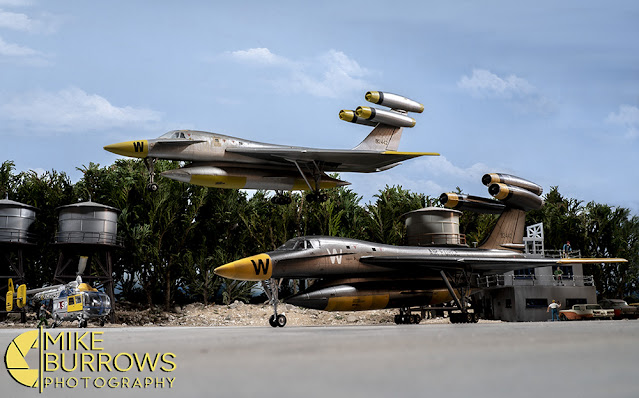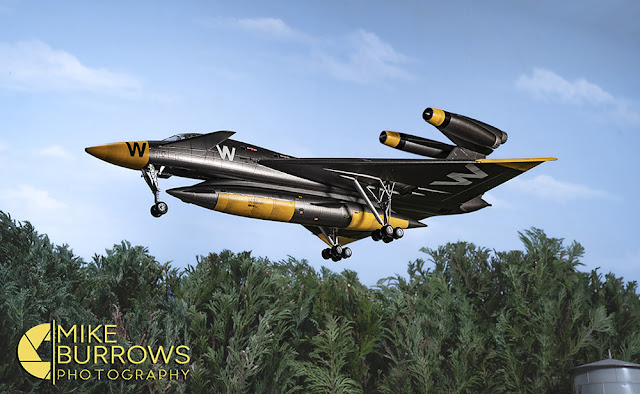Some photos of my WASP ‘Spearhead’ bomber, as seen in Gerry &
Sylvia Anderson’s TV series, Stingray.
The model is a
fairly simple build and uses a 1:72 scale Italeri Convair B-58
Hustler kit, which needs little alteration. Of course, the most
obvious change is 3 of it’s 4 turbojet engines are attached to the
tail fin rather than the wings, along with the addition of a couple
of forward canards made from plastic card. There are a couple of
subtle changes; The fins on the under fuselage weapons pod needed to
be repositioned, and I left the plastic glass out of the rear cockpit
windows. When the landing gear is fitted, the fold down doors are
left off.
The position of the
engines, often a point of debate for the more pedantic aircraft
enthusiasts who forget it’s fictional, means the model needs to be
weighted towards the front, otherwise it will just tip back.
I added a large ‘W’
under the starboard wing. I can’t say for sure whether the filming
props had that, as my screen captures of the aircraft viewed from
below showed something that could be a ‘w’, but wasn’t at all
clear. Nevertheless, I like the look. I’ve noted some modellers
have also added a large’ W’ on top of the port wing, but I
decided against that.
The model is painted
in Hycote gunmetal, and Revell matt yellow, followed by some light
weathering. After applying the Letraset lettering and some of the
supplied decals, the model was finally sprayed with a matt sealer.
I did make a
Spearhead bomber using a similar kit, some 35 years ago, when my
reference material was a bit thin on the ground. I sprayed that one
silver, and for the yellow detailing I used pale matt yellow enamel
paint.
The original studio
models were made from Aurora 1:76 scale Hustler kits. As these are
long out of production, the Italeri kit is a cheaper and much easier
to find alternative.
I'm told that they may have also used Revell and Lindberg kits, too.
Around a dozen
Spearhead models were produced for Stingray, some in flying
mode and some with landing gear fitted.
The models were
built by studio model makers, Richard “Eric” Backman, and Ezra
Dearing (born William Jones). Both worked on several of the
Anderson’s productions. Eric had already worked on the Anderson’s
previous puppet series, Fireball XL5. Ezra was in his mid fifties
when he worked on Stingray, making him one of the oldest people to
have worked for the studio.
In the series the
Spearhead jet squadrons are used as multi-task aircraft. Apart from
their main role as a vertical take-off jet bombers, they can double
as V.I.P. passenger transporters, as well as able to participate in
search and rescue operations.
As they are seen
in the opening titles, the Spearhead jet squadron appear in every
episode of Stingray. They feature in the opening episode story as
aerial search aircraft.
In ‘Emergency
Marineville’ two Spearhead aircraft bomb Baul Island, a base used
by undersea aliens, Nucella and Chidora, who have launched several
surprise missile attacks on Marineville.
In ‘Pink Ice’,
a Spearhead bomber, complete with a WASP Arrowhead fighter escort is
used to transport Comr. Shore from WASP HQ in Washington back to
Marineville.
In ‘A Nut for
Marineville’, the eccentric Professor Burgoyne is tasked to develop
a new nosecone for Stingray’s sting-missiles, and is flown to
Marineville aboard an executive Spearhead bomber.
Using
the Convair B-58 Hustler, as a basis for the WASP Bomber was
arguably, a good choice. It was without doubt, a sleek, and capable
looking aircraft, very advanced and had not long entered operational
service as a state-of-the-art Nuclear bomber when Stingray was being
produced.
The
B-58 was the fastest bomber at that time, capable of Mach 2 (1375
mph) at high altitude, and had a range of 5115 miles, combining fuel
from it’s internal and it’s under-fuselage fuel pod.
It
could fly for up to 18 hours carrying a payload of up to six nuclear
weapons to any target on the globe.
B-58
Hustlers appear as fictitious ‘Vindicator’ bombers in the 1964
Cold War thriller, Fail Safe, and later, the 2000 made-for-TV
remake.
It
was, however a difficult aircraft to fly, and cost a fortune to
maintain. It entered service during March, 1960, and was retired just
ten years later, in January, 1970.
https://mikeburrowsphotography.co.uk/


.webp)
.webp)
.webp)



.jpg)














